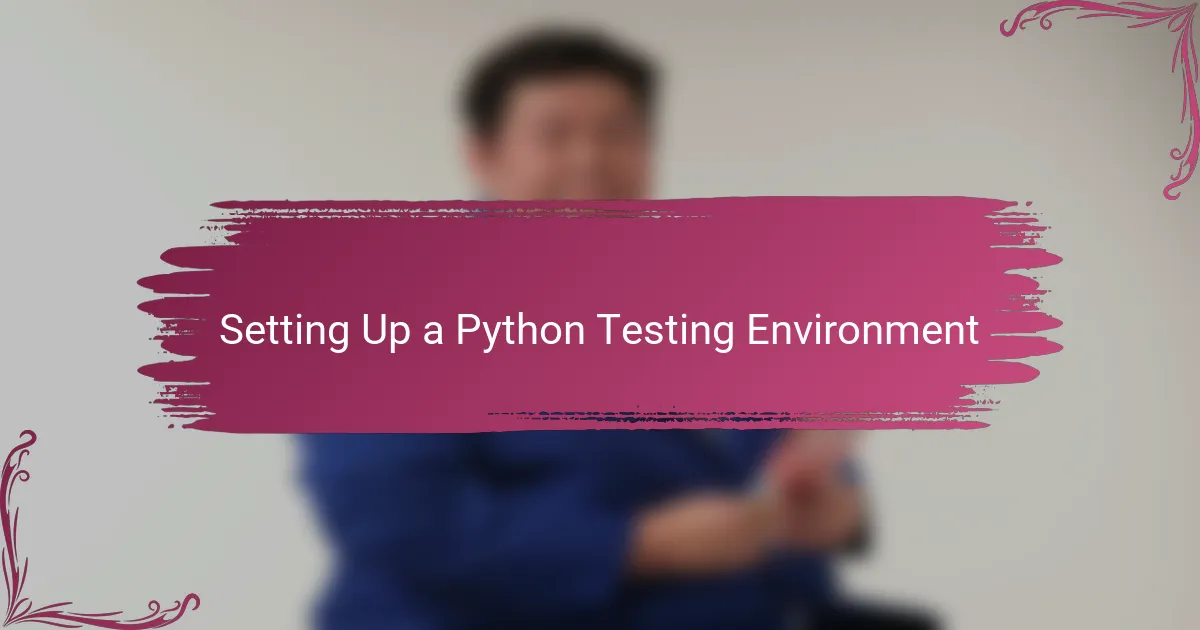Key takeaways
- Unit testing is essential for catching bugs early and providing confidence in code reliability.
- Utilizing Python’s unittest module simplifies the process of asserting expected outcomes and encourages immediate feedback.
- Setting up a dedicated testing environment and using a fitting IDE can significantly enhance productivity and ease of testing.
- Best practices include keeping tests focused, using clear naming conventions, and running tests frequently for effective debugging.

Introduction to Unit Testing
Unit testing has always struck me as a crucial step in writing reliable code. When I first started programming, I often overlooked it and ended up chasing bugs in ways that felt like a never-ending game of whack-a-mole. Have you ever felt that frustration of fixing one problem only to encounter another? That’s exactly where unit tests come in—they help catch issues early by testing the smallest parts of your code independently.
The beauty of unit testing lies in its simplicity: you write small, focused tests for each function or method, ensuring they behave as expected. I found that this approach not only boosts confidence in my code but also makes future changes less intimidating. It’s like having a safety net that keeps your work stable no matter how many twists and turns your project takes.
Over time, running unit tests became less of a chore and more of a satisfying checkpoint in my coding routine. There’s something rewarding about seeing all tests pass, knowing that your code is solid. Have you tried it yourself? Once you experience that peace of mind, it’s hard to go back.

Understanding Unit Testing in Python
When I first dove into unit testing with Python, understanding the framework felt a bit like learning a new language within a language. Have you noticed how Python’s built-in unittest module mirrors a familiar style? It organizes tests into classes and methods, which at first seemed formal, but soon I appreciated how it brought order to my testing chaos.
What I really like about Python’s unit testing is how straightforward it makes the process of asserting expected outcomes. For example, I could write a test to check if a function returned the right value using simple statements like assertEqual, and it felt like having a direct conversation with my code—asking questions and expecting clear answers.
I also found that the ability to run these tests automatically changed how I approached coding. Instead of waiting until the end to verify everything, I could get instant feedback, which sparked a sense of progress and kept me motivated. Do you remember the first time you saw all your tests pass right after a change? That moment feels like a small victory worth celebrating.

Setting Up a Python Testing Environment
Setting up a Python testing environment felt a bit daunting when I started, but it quickly became one of the smartest moves I made. Have you ever wrestled with running tests only to run into version conflicts or missing packages? Installing a dedicated virtual environment with tools like venv saved me from a lot of headaches by isolating my project’s dependencies.
I remember how installing pytest and unittest through pip was my gateway to smooth testing sessions. It was as simple as running a couple of commands, yet it opened up a whole new level of efficiency. Once everything was set up, running tests from the command line became a natural part of my workflow.
Choosing the right IDE or editor also made a huge difference. I found that using editors like VS Code with Python extensions offered handy test runners and debugging tools right at my fingertips. Having that kind of integration felt like having a friendly assistant guiding me through the testing process, making the entire experience less intimidating.

Writing Your First Unit Test in Python
Writing your first unit test in Python was a moment that really shifted how I viewed coding. I remember staring at a simple function and wondering, “How do I even test this?” But once I created a small test class using unittest.TestCase and wrote a method starting with test_, it suddenly clicked. It felt like having a direct line to my code, asking it, “Are you working as you should?”
I started small—just testing one function output with assertEqual—and was surprised how satisfying it was to see that test pass on the first try. Have you ever felt that rush of confidence? It made me realize writing tests wasn’t about complexity but about building trust in my code, one tiny test at a time.
Another thing that helped me was naming tests clearly and focusing each test on a single behavior. This simple habit saved me from headaches later when something failed. I found troubleshooting easier because I knew exactly which part of the code was misbehaving, and that clarity made all the difference.

Running and Debugging Unit Tests
Running unit tests in Python became a daily ritual for me once I integrated them into my workflow. I usually kicked things off in the terminal with a simple command like python -m unittest, and seeing each test result appear line by line gave me that reassuring feeling that my code was holding up. Have you ever experienced that subtle excitement when you watch tests pass, knowing your recent changes didn’t break anything?
When bugs did sneak in, I found debugging within the unit testing framework straightforward but powerful. Adding print statements felt old-school, so relying on tools like breakpoints inside my IDE—VS Code being my go-to—transformed the process. Pausing execution right where things went wrong made the bug hunt less frustrating and more like solving a puzzle. Isn’t it satisfying when you finally catch a sneaky error in the act?
One practice I picked up was running tests frequently during development instead of waiting for a whole batch to complete. It turned catching errors into quick, manageable moments rather than overwhelming debugging marathons. I’d ask myself, “Does this small change break anything?” and run the relevant tests immediately. That habit saved me countless headaches and made maintaining code quality feel less like a chore and more like a natural part of coding.

Best Practices for Python Unit Testing
When it comes to best practices for Python unit testing, one lesson I learned early is to keep tests small and focused. I’ve found that testing one specific behavior per test makes it much easier to spot the exact cause when something breaks. Have you ever spent ages hunting bugs only to realize a loosely defined test was hiding the real problem? Precise, targeted tests save you from that frustration every time.
Another habit that reshaped my testing game was using meaningful and consistent test names. It might seem trivial, but naming tests clearly felt like giving my future self a map through the maze of code. Whenever a failure popped up, I knew exactly where to look without scrolling endlessly. Creating that clarity not only speeds up debugging but also builds trust in your test suite’s usefulness.
Finally, I can’t stress enough the value of running tests frequently during development. Waiting until the end to test felt like inviting chaos in. Instead, I started running tests after every small change, turning bugs from monstrous surprises into quick fixes. Do you remember how empowering it feels to catch errors live before they grow out of control? That steady feedback loop transformed testing from a chore into a natural part of my workflow.